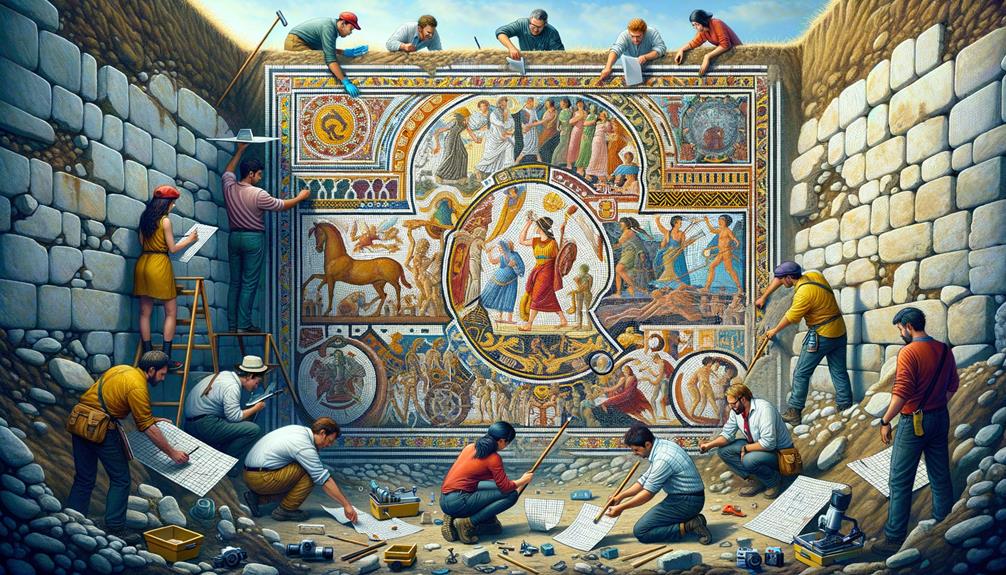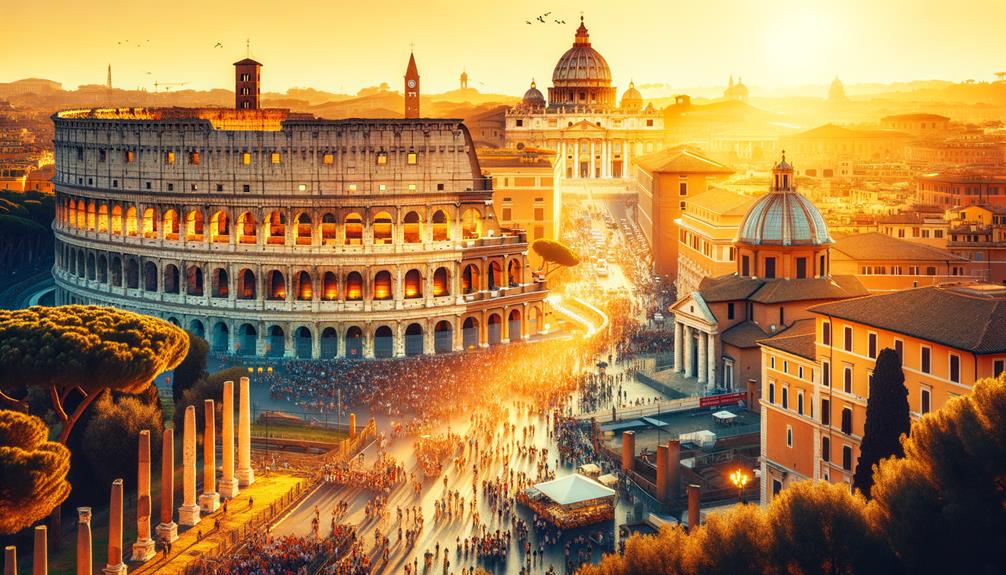Strolling through the peaceful streets of Ravenna, I was mesmerized by the sunlight dancing on ancient mosaics, each shimmering tile a piece of history. The Basilica of San Vitale, with its intricate corridors and lavish mosaics, provided a window into the splendor of Byzantine art. As I examined the vivid patterns and meaningful iconography, I was in awe of the stories captured in stone, quietly sharing tales of early Christianity and cultural exchange. But it was the Mausoleum of Galla Placidia that truly brought Ravenna's mosaic art to life, leaving me eager to learn more.
Historical Significance
Walking through the ancient streets of Ravenna, I'm amazed by its stunning mosaics that showcase the city's rich and diverse history. These intricate artworks, created over centuries, reveal the essence of an era shaped by Byzantine influence. As I wander through the Basilica of San Vitale, the grandeur of the mosaics strikes me—each piece carefully placed to tell both spiritual and political stories.
Nearby, the Mausoleum of Galla Placidia stands as another testament to the city's mosaic artistry. The interior, glowing with deep blues and golds, creates an almost otherworldly atmosphere. The designs here are just as captivating, narrating tales of faith and power.
The Basilica of Sant'Apollinare Nuovo also deserves mention. Its long nave is adorned with panels depicting biblical scenes, reflecting the early Christian era. It's clear why these sites, among others in Ravenna, have earned a spot on the UNESCO World Heritage list. Each mosaic tells stories from a bygone era, inviting me to lose myself in their timeless beauty.
Basilica of San Vitale
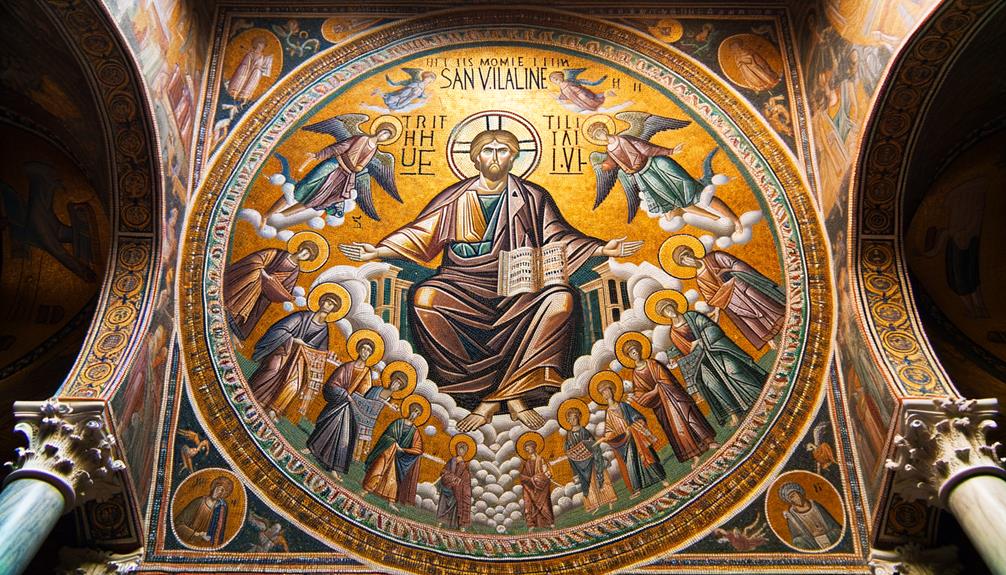
Stepping into the Basilica of San Vitale in Ravenna, your eyes are immediately drawn to the vibrant mosaics depicting both heavenly and earthly figures. This architectural gem, completed around the mid-6th century, blends Roman and Byzantine styles into a stunning work of art. The basilica's design features two concentric octagons topped with a towering dome, creating a space that feels both grand and intimate.
The mosaics are truly spectacular. Gold tesserae, brought from Byzantium, shimmer in the light, adding a divine glow to the scenes. The Redeemer stands proudly between San Vitale and Bishop Ecclesius, surrounded by tesserae made from ceramics, glass, stone, marble, and mother-of-pearl. Each piece seems to come to life, telling stories of faith and power.
Consecrated in 547, the apse of San Vitale offers a remarkable series of interconnected mosaics. These mosaics relate to each other in a complex, almost narrative dance, inviting anyone who visits to ponder the deeper theological messages within. Fully understanding this interconnectedness might require watching a video, but even at first glance, the beauty is captivating.
In Ravenna, the Basilica of San Vitale stands as a timeless testament to human creativity and spiritual devotion.
Mausoleum of Galla Placidia
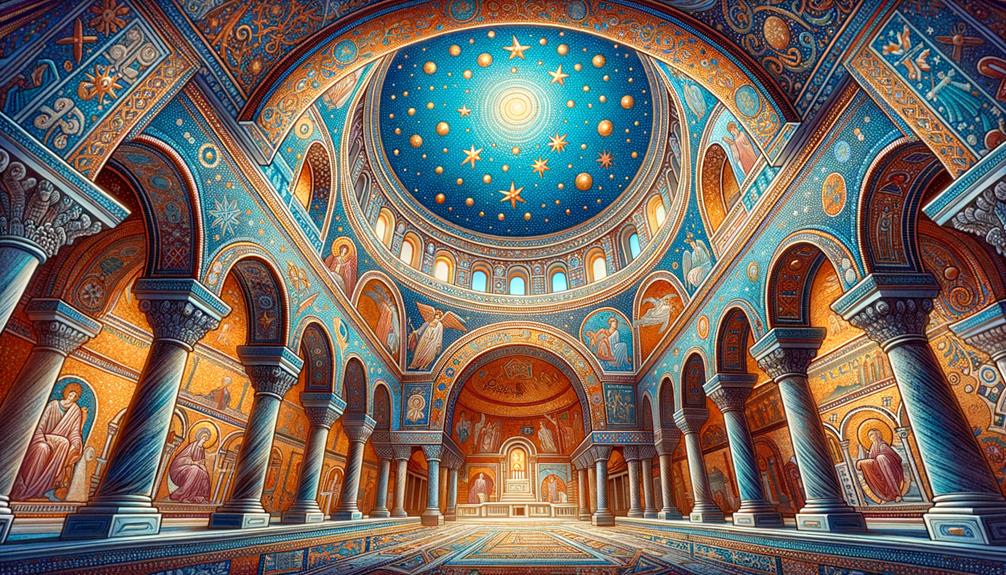
When I walked into the Mausoleum of Galla Placidia, the cozy design of the place immediately drew me in. The famous mosaics, with their bright colors and detailed patterns, seemed to share stories of faith and eternity. Knowing its historical importance, I felt deeply connected to the early Christian era and the legacy of Empress Galla Placidia.
Architectural Design Features
Entering the Mausoleum of Galla Placidia, the difference between its plain brick exterior and the stunning mosaic interior hits me right away. This small, cross-shaped building from the 5th century hides a dazzling inner world that showcases the rich mosaic heritage of Ravenna. The architecture blends Roman and Byzantine styles, reflecting the shared cultural and artistic traditions of both empires.
Inside, the central square space surrounded by four barrel-vaulted niches immediately stands out. The vaults, covered with intricate mosaics of stars, flowers, and other ornate designs, create a celestial atmosphere that feels both beautiful and harmonious. These mosaics, vibrant and meticulously crafted, represent the peak of Byzantine art.
While you can sense the influence of the Basilica di San Francesco, the Mausoleum of Galla Placidia has its own unique and cohesive design. The mosaics and architectural elements here aren't just decorative; they tell a story of cultural exchange and artistic growth, making every moment spent inside a journey through history.
Iconic Mosaic Imagery
Stepping into the Mausoleum of Galla Placidia, my eyes are immediately drawn to the stunning mosaic of Christ the Good Shepherd, surrounded by a lush, green landscape dotted with sheep. The mosaic's vibrant colors, made from tiny pieces of colored glass, shimmer in the dim light, creating a sense of divine presence that's almost tangible.
These mosaics are some of the finest examples of Early Christian art. As I admire the intricate details, I can't help but recall the beautiful Byzantine mosaics I saw at Sant'Apollinare in Classe. The themes are similar, but the execution here feels more intimate and personal.
| Location | Featured Imagery | Notable Elements |
|---|---|---|
| Mausoleum of Galla Placidia | Christ the Good Shepherd | Colored glass, green landscape |
| Sant'Apollinare in Classe | St. Apollinare amidst stars | Byzantine mosaics |
| Other Ravenna Sites | Various Biblical scenes | Rich iconography |
Walking through, I'm enveloped by the mastery of the mosaics in Ravenna. Each scene tells a story; each tile is a tribute to the devotion and skill of the artists. The vivid colors and divine imagery transport me back to a time when faith and art were intertwined, each enhancing the other in a dance of light and spirituality.
Historical Significance Unveiled
Walking into the Mausoleum of Galla Placidia, I'm struck by its historical and artistic significance, a testament to the enduring legacy of Early Christian art. Located in Ravenna, this 5th-century structure stands as a symbol of the Roman Empire's cultural heritage. Inside, the shimmering light from thousands of colored glass pieces, carefully arranged by Byzantine artists to depict biblical scenes, greets me.
These mosaics are more than just art; they tell a story of faith and craftsmanship. The vibrant blues, golds, and greens create a heavenly atmosphere, making it feel like I've entered another world. The imagery embodies the essence of Early Christian art, with symbols of resurrection and eternal life. It's incredible to think these vibrant mosaics have lasted for over 1,500 years, showcasing the skill and dedication of the artisans.
Galla Placidia, daughter of Emperor Theodosius I, commissioned this mausoleum not only as her final resting place but also as a testament to faith and power during the last days of the Western Roman Empire. It's a humbling reminder of the grandeur of the past and the timeless beauty of Ravenna's cultural heritage.
Basilica of Sant'Apollinare Nuovo

Walking into the Basilica of Sant'Apollinare Nuovo, the historical significance hits you immediately. The mosaics, depicting virgins and martyrs on either side of the nave, are not just visually stunning—they're full of iconography and symbolism that reveal a lot about early Christian beliefs. Restoration efforts have carefully preserved these artworks, letting us admire the vibrant colors and exceptional detail crafted by ancient artisans.
Historical Significance Unveiled
In the heart of Ravenna, the Basilica of Sant'Apollinare Nuovo stands as a testament to its rich history, adorned with stunning early Christian mosaics that transport visitors back to the splendor of the Byzantine Empire. These mosaics, dating back to Emperor Justinian's reign, highlight the church's storied past. Originally constructed by Theodoric the Great in the early 6th century, the basilica was later consecrated as a Christian church by Bishop Ecclesius and named after Saint Apollinaris, Ravenna's patron saint.
Walking through the basilica, the vibrant colors and intricate designs of the Byzantine mosaics are mesmerizing. The walls seem to tell stories of faith and power, echoing the essence of a bygone era.
- Emperor Justinian: His influence is clear in the mosaics, symbolizing the reach of the Byzantine Empire.
- Mosaics Date: These artworks, preserved since the 6th century, offer a glimpse into early Christian art.
- Church in Ravenna: This basilica is a key monument reflecting Ravenna's significance as a center of early Christianity.
- Bishop Ecclesius: His role in consecrating the church underscores its religious importance.
Iconography and Symbolism
Stepping into the Basilica of Sant'Apollinare Nuovo, the detailed mosaics immediately grab my attention, pulling me into the rich spiritual and cultural stories they tell. These Byzantine mosaics are more than just decoration; they're a visual expression of faith and history. The Good Shepherd stands out in the apse, his calm presence symbolizing guidance and protection.
Each mosaic is a carefully crafted story with deeper meanings. The procession of saints, adorned with golden halos and flowing robes, represents the heavenly court and the promise of eternal life for the faithful. Walking through the nave, I'm struck by the vivid biblical scenes filled with symbolism—fish symbolizing Christ, lambs representing his followers, and the cross as a sign of ultimate sacrifice.
In Sant'Apollinare, these mosaics are both religious lessons and artistic marvels, creating a timeless conversation between the divine and human. Ravenna's mosaic art invites us to interpret and reflect, offering a journey through the rich tapestry of early Christian iconography.
Restoration Efforts Detailed
Restoration efforts at the Basilica of Sant'Apollinare Nuovo have breathed new life into the ancient mosaics, revealing their original splendor and intricate details. Walking through the basilica, I was struck by the vibrant colors and the meticulous craftsmanship brought to light by the restoration. This project, led by the Italian Ministry of Cultural Heritage and Activities, aimed to preserve the 6th-century Byzantine mosaics using original materials and techniques.
The process was nothing short of fascinating. Here are a few highlights:
- Advanced Technologies: The team used 3D scanning and infrared reflectography to analyze damage and deterioration, ensuring no detail was overlooked.
- Removal of Past Restorations: Old, inconsistent restoration efforts were carefully removed to restore the mosaics' authentic appearance.
- Reintegration of Fragments: Original mosaic fragments, lost or removed over time, were reintegrated, bringing back the intricate designs.
- Skilled Team: A dedicated team of conservators, restorers, and historians, along with international experts, worked tirelessly from 2006 to 2015.
As I stood there, I felt a deep connection to Ravenna's rich cultural tapestry. The restoration of these mosaics not only preserves Byzantine art but also tells the enduring Italian story of resilience and beauty.
Neonian Baptistery
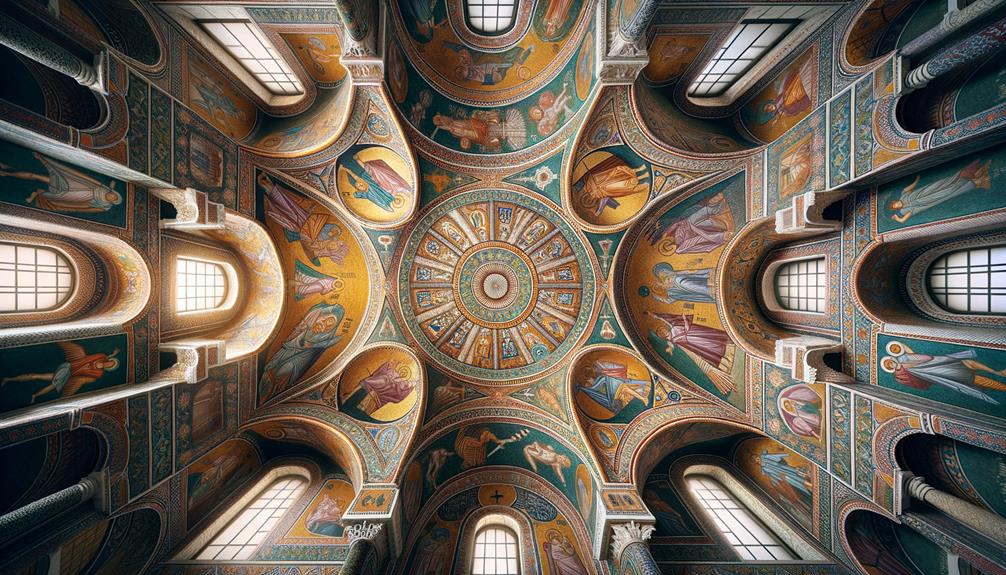
Walking into the Neonian Baptistery, you're immediately struck by the stunning mosaics adorning its ancient dome. Each tile tells a vivid biblical story, making you feel like you've stepped back in time. This 5th-century marvel in Ravenna, Italy, is a tribute to the grandeur of Byzantine art. The vibrant colors and intricate details of the mosaics are truly breathtaking. The depiction of the Baptism of Christ is particularly captivating, so realistic that the water almost seems to ripple.
As one of Ravenna's eight UNESCO World Heritage Sites, the Neonian Baptistery highlights the rich cultural and artistic influences of the Eastern Roman Empire. The octagonal structure, with its Byzantine architecture, carries a deep sense of historical significance. Each remarkably well-preserved mosaic tile, after more than 1,500 years, offers a glimpse into a time when art was a powerful medium for storytelling and spiritual expression. Standing amidst these ancient masterpieces, you can't help but feel a profound connection to the past and a deep appreciation for the timeless beauty of Byzantine mosaics.
Visiting Tips
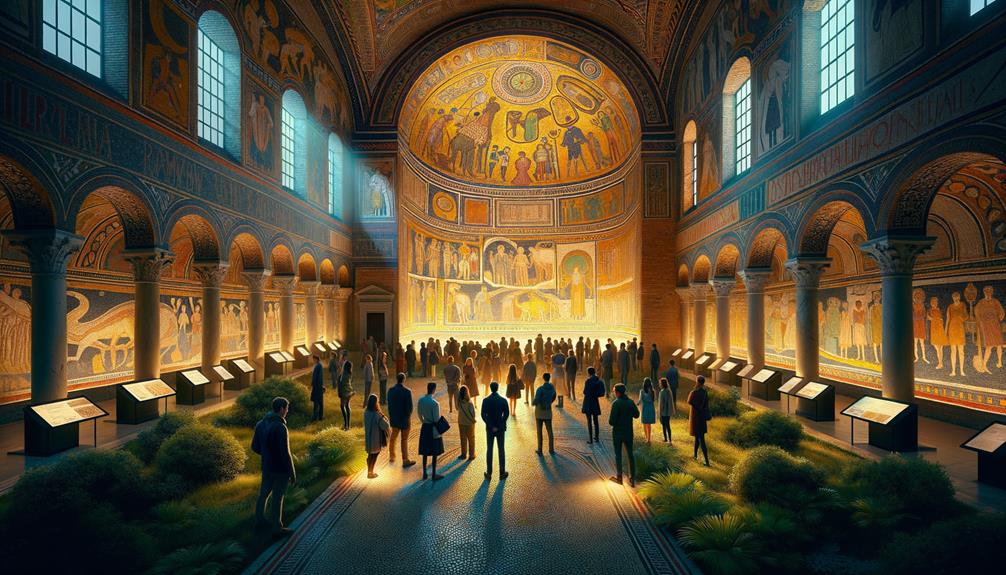
Standing amidst the stunning mosaics of the Neonian Baptistery, I felt a surge of excitement to uncover more of Ravenna's hidden treasures. With a few handy tips, you can make the most of your visit to this mosaic-rich city. Ravenna's charm isn't just in its mosaics but also in its rich history, culture, and ease of exploration.
First, consider getting a combined ticket. For just 12.5 EUR, this ticket grants access to multiple mosaic-filled sites, including the Basilica of Sant'Apollinare Nuovo and the Mausoleum of Galla Placidia. It's valid for 7 consecutive days, so you have plenty of time to explore.
Plan your trip based on your interests and book accommodations and attractions in advance to dodge the crowds. The city's tourist information offices and guides offer valuable insights to help you navigate Ravenna's many attractions.
Getting to Ravenna is simple. You can fly into Bologna and then take a train or bus, or drive and park near the main sites.
Consider visiting in the autumn. The weather is mild, and there are fewer tourists, allowing you to enjoy the city and its mosaics at a leisurely pace.
Here's a quick checklist to help you:
- Get the combined ticket: Access multiple sites for 12.5 EUR.
- Plan in advance: Book accommodations and attractions early to avoid crowds.
- Transportation options: Fly into Bologna or drive directly to Ravenna.
- Visit in autumn: Enjoy milder weather and fewer tourists.
These tips will help make your visit to Ravenna as smooth and enriching as the mosaics themselves.
Frequently Asked Questions
Why Are the Mosaics of Ravenna Important?
I strolled through the old streets of Ravenna, mesmerized by its mosaics. These artworks are significant because they tell a visual story, blending Roman and Byzantine styles. The colorful designs give us deep cultural insights and reflect humanity's enduring desire for beauty and expression.
What Is the Best Mosaic in Ravenna?
I think the best mosaic in Ravenna has to be the apse mosaic in San Vitale. Its detailed design, bright colors, and outstanding craftsmanship are truly impressive, making it a memorable experience for anyone interested in culture.
What Is the Oldest Mosaic in Ravenna?
I took a stroll through the Basilica di San Apollinare Nuovo and was amazed by its oldest mosaic, which dates back to the early 6th century. Each piece captures stories of ancient faith and artistry, bringing history to life with vivid colors.
What Is the Ravenna Method of Mosaics?
The Ravenna method of mosaics is a fascinating process that involves placing small, hand-cut tesserae into wet mortar. The detailed craftsmanship is impressive, with each piece reflecting the rich history and cultural significance of this ancient art form.

